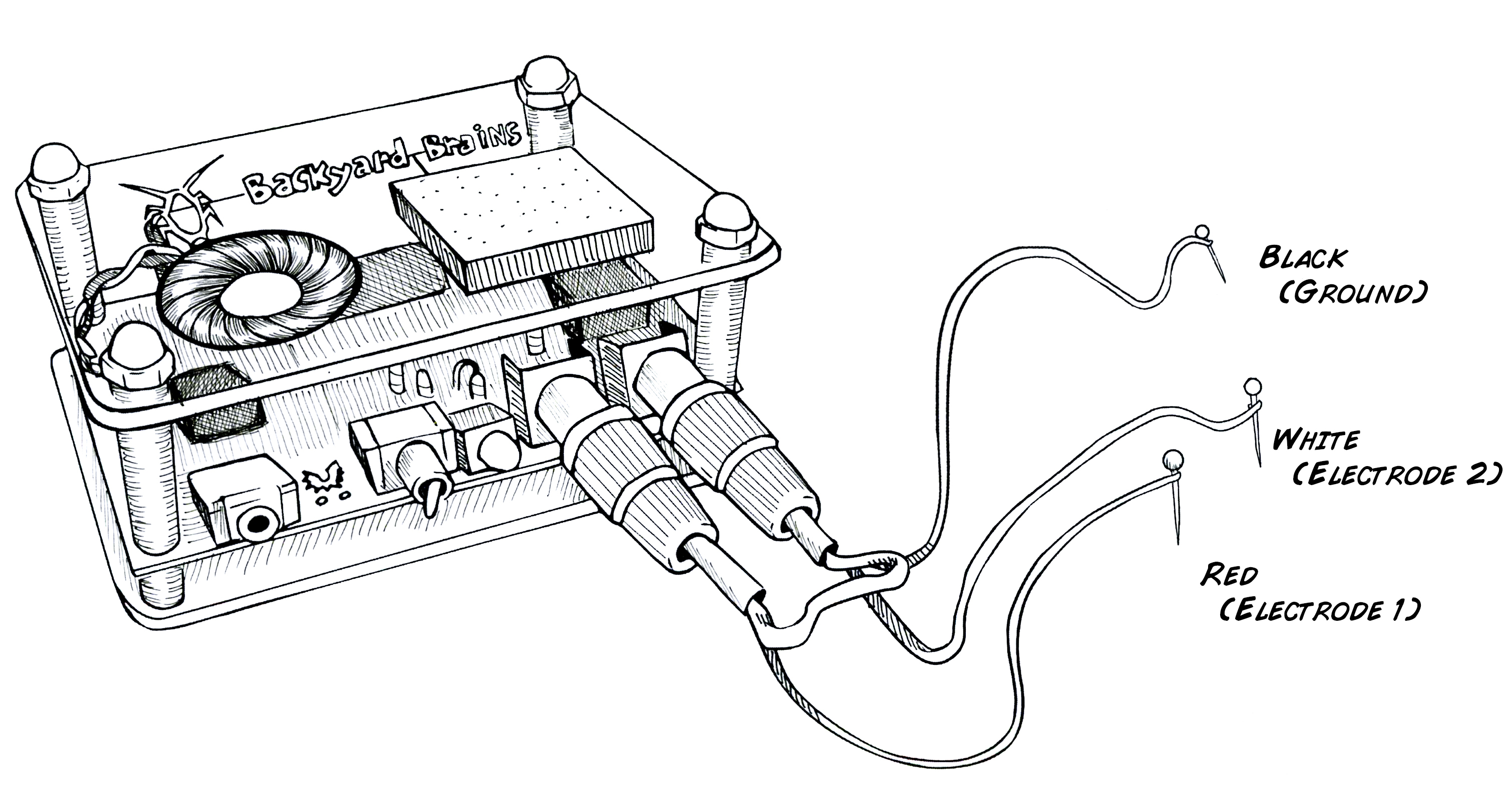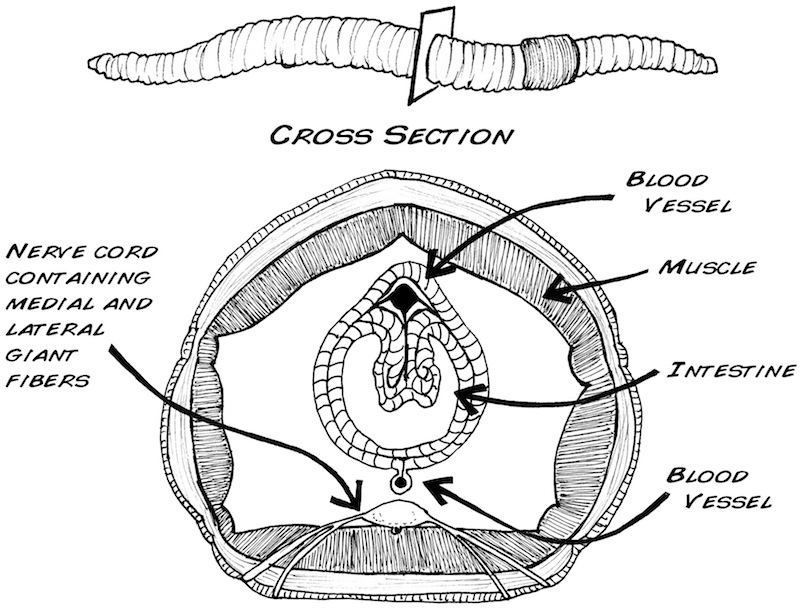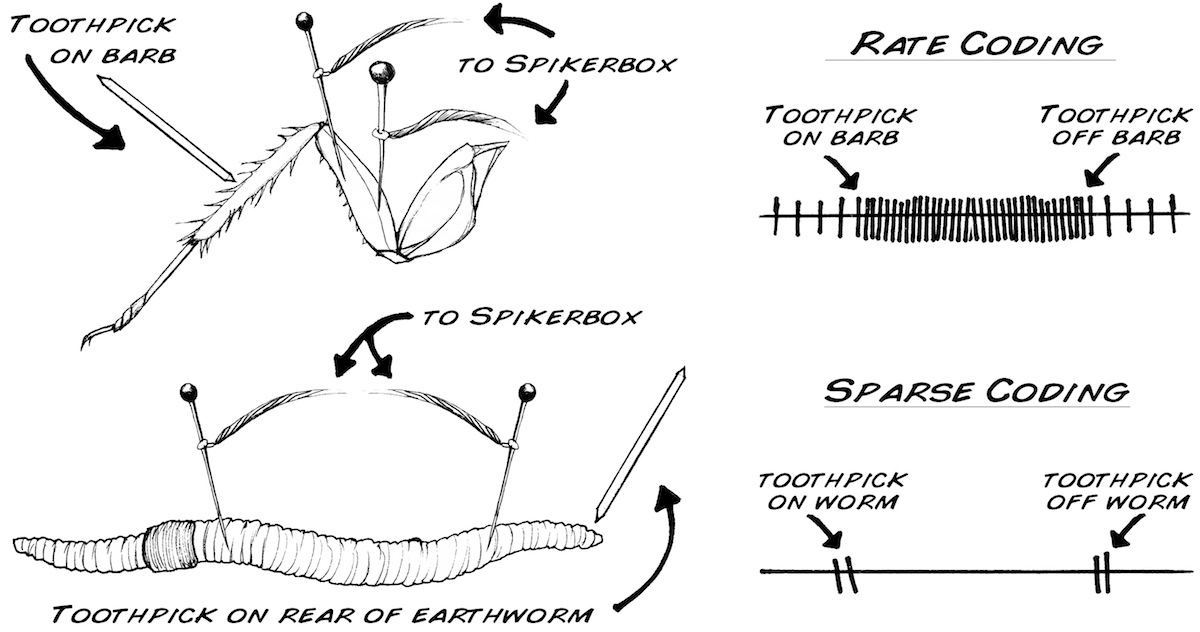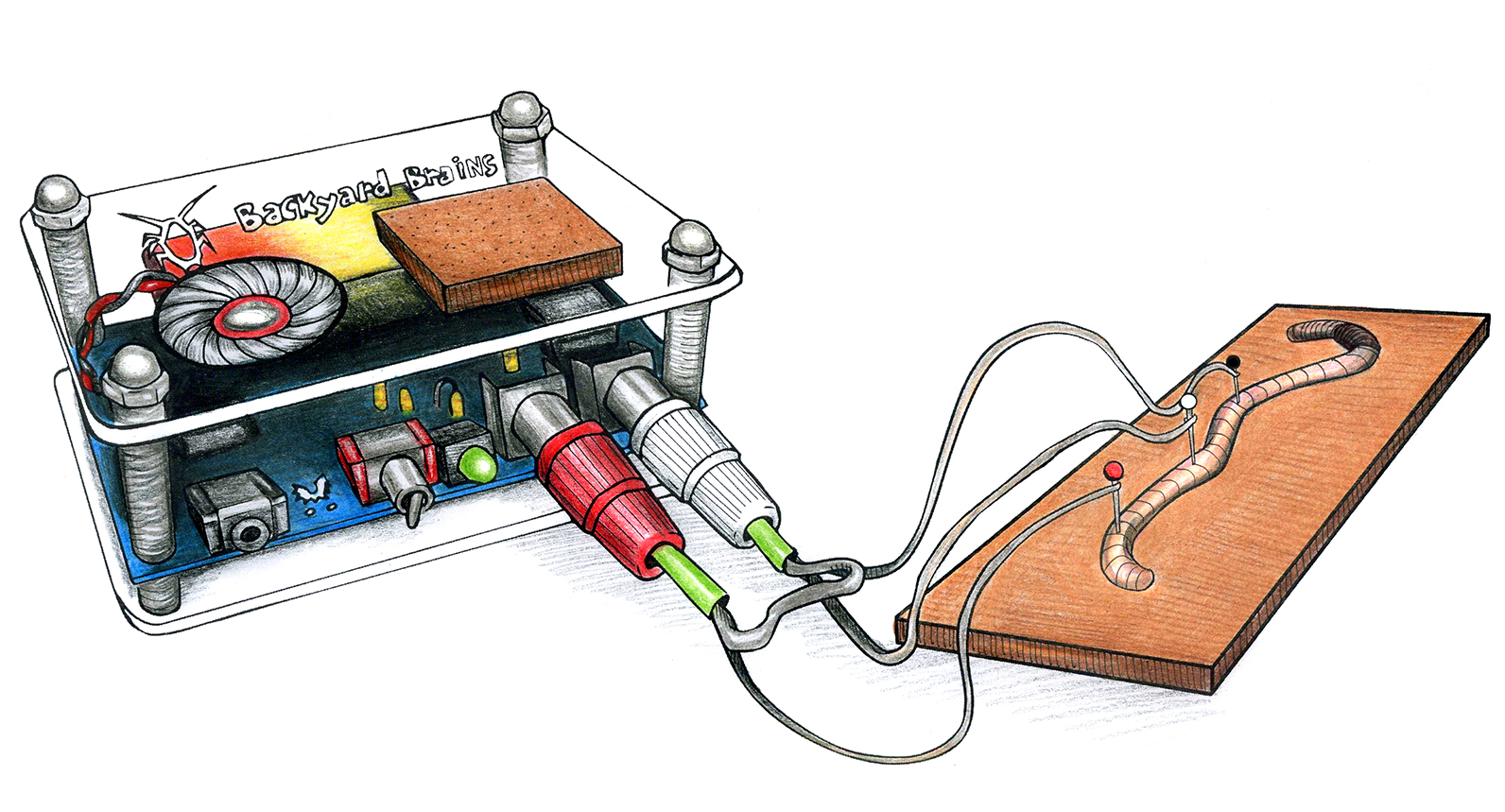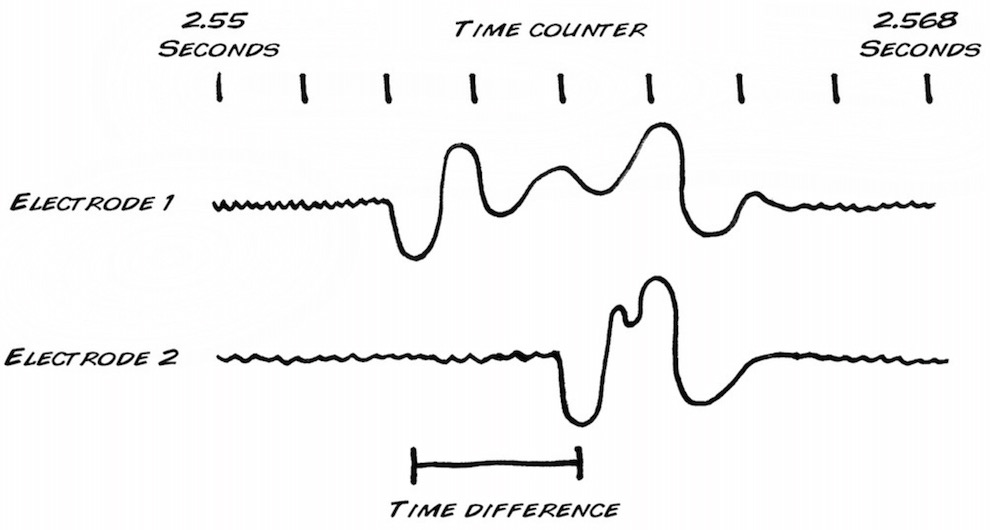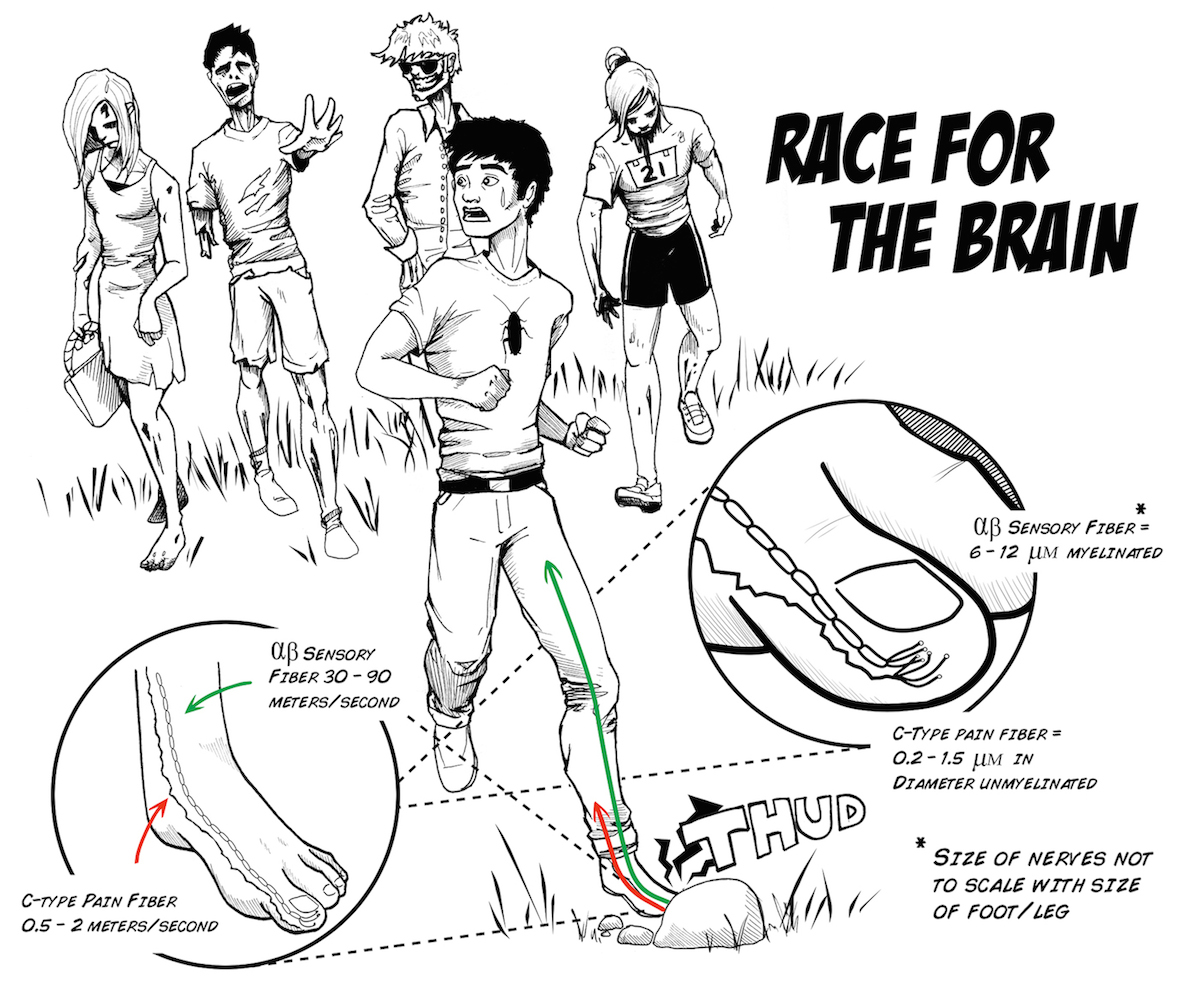Experiment: Conduction Velocity-How Fast is a Neuron?
You have probably spent some time wondering just how fast those spikes that you have been studying are? Now you can find out with our 2-Channel SpikerBox and an earthworm!
Was lernt man hier?
In this lab you will learn how to measure the conduction velocity of a spike using an earthworm. You will also learn about "Sparse Coding," a different neural code than the "rate coding" we have been previously studying.
Voraussetzung
- SpikerBox
- Rate Coding
- Referencing your Spikes
- Faraday Cage
This is an advanced lab, and we recommend you go first through several of the beginner and intermediate labs:
Background
Note: This experiment was recently peer-reviewed and published by the American Physiological Society in the journal "Advances in Physiology Education" - Read the paper intrepid scientists! for a more in-depth treatment of the experiment described below.
Up to this point we have been studying spikes emitted from crickets and cockroaches, mostly by monitoring the "spike rate" and "spike presence" in response to certain stimuli or conditions. We now will study "spike speed."
You probably think the nervous system is pretty fast. You seem to hear the spikes immediately when you touch the leg of the cockroach or blow on the cerci of the crickets. But is it instantaneous? Of course not! Not even light, the fastest signal in the universe, travels instantaneously. But how fast is a nervous system? Is it faster than a car, faster than a jet plane, or faster than a cell phone? And how can we measure it?
In all previous experiments, we've only recorded our neurons using one channel (meaning we used only one recording electrode and one ground). To measure speed (velocity) though, you need to measure both time (when a spike occurred) and distance (how far a spike has traveled down a nerve).
Take the analogy of a car on a highway. If you were looking out of a small observation hut by the road, you could tell what whether you saw a car, what kind of car it was, and the time that you saw it.
Similarly with your SpikerBox, you can tell if you saw a spike, perhaps what kind of neuron generated that spike, and the spike time, but you can't tell how fast the spike was traveling down the nerve.
Let's go back to the car on the highway. Suppose you had a friend 1/2 mile down the road in a similar hut: Later, you two could compare notes to determine the speed of the car.
1 minute = 0.016 hours. Dividing 1/2 mile by 0.016 hours, you calculate a speed of 31.25 mph. Thus, we can measure the speed with two observers, and that's why we hereby announce the "2-Channel SpikerBox" to measure two points along a nerve as a spike travels down it.
So, why don't we take our 2-Channel SpikerBox with our two electrodes and ground, put it in the cockroach, and measure the spike output of the two channels? You will notice immediately that there are a lot of spikes happening on both channels, in fact, way too many to keep track of it all.
Let's go back to our analog of the road. Imagine a very busy, fast moving street with many similar looking cars, say, Lakeshore Drive in Chicago, and you and your friend can only set up observation huts very close to each other.
You can see the problem, There are a lot of spikes occurring in the cockroach leg, and identifying unique ones with two observers is very tricky. The femur of cockroach leg has 2 nerves inside, and inside each nerve is about 100-200 neurons, all firing many spikes. We are also limited by how far we can place our electrodes from each other in the cockroach leg, as the leg is only about 8 mm long.
Ideally, given our limited tools, we'd want to measure spikes on a longer nerve, a nerve with only 1-3 large axons in it, and axons that do not fire many spikes.
Is there any creature in the animal kingdom that meets these qualifications? Yes! and it is probably right now under your feet and in your backyard.
We have been studying arthropods (insects), but we now move to a new class of invertebrate: annelids! Or more commonly, worms! Enter our newest preparation: the common earthworm, Lumbricus terristrius. It's a simpler animal than what we've studied before, and the earthworm contains three large axons that run its length, the "medial giant" fiber and the two "lateral giant" fibers. The medial giant fiber transmits information about the front of the worm (the part closest to the clitellum), and the lateral giant fibers transmit information from the skin cells of the posterior end of the worm (Kladt et. al 2010).
In addition to the earthworm's long length, which allows us to place our recording electrodes far apart, the earthworm also exhibits what is known as
What is sparse coding? Let's turn back to our cockroach and the "rate coding" you have previously studied. In rate-coding, the intensity of a stimulus is encoded by the rate of spikes. If the cockroach leg used a sparse coding scheme, the leg nerves would only fire 1-2 times when you touched the barb with a toothpick, and 1-2 times more when you removed the toothpick.
This sparse coding scheme is what we will see in the earthworm experiment below, and we will exploit it to measure the conduction velocity (or speed) or the spikes. Here is a video describing the experiment:
Downloads
Video
Note: The video below is a more recent July 2015 video on our worm stretch experiment, but serves as a tutorial to use our new software, and the procedure is effectively the same. You can view the original December 2011 video here.
Procedure
Materials Required
- 2-Channel SpikerBox
- Earthworm
- A Faraday Cage
- Laptop with stereo line-input
- Patch/Laptop Cable
- Ruler
- Balsa Wood or styrofoam for Worm
- Alcohol or Seltzer Water
- 2 small plastic tubs, one filled with water, the other filled with the alcohol/seltzer water anesthetic
- Modern laptops, over the past four years, have stopped having stereo audio inputs. We recommend the iMic to provide stereo audio input to your computer.
- Go to your nearest pet store, sporting goods store, or gas station and purchase a box of earthworms (they are typically used to feed lizards, turtles, and fish. Fishermen use them as bait). They should be around $3-$4 for 12 worms. The Earthworm box should stay in the refrigerator (not the freezer) when not being used. The worms can last approximately 1-2 months.
- Prepare a 10% ethanol solution. The easiest way to do this is to use vodka (which is normally 80 proof, or 40% ethanol). Since Vodka is not much more than watered down pure ethanol, dilute it further to 1 part vodka, 3 parts water. For example, we mix 10 milliliters of alcohol with 30 milliliters of tap water. Ask your teacher to prepare this for you. Note: You can also use sugar-free carbonated water (also called club soda or sparkling water) as an anesthetic if ethanol is not available. The CO2 in the water serves as an anesthetic agent.
- Place a healthy earthworm in the alcohol mixture and wait seven minutes. Do not wait too long; as with human anesthesia, the delicate balance between too little anesthesia and too much is tricky. Too little anesthesia, the earthworm will move around during the experiment, and the resulting muscle electrical activity (electromyogram) will drown out the small neural electrical signals you are interested in. Too much anesthesia and the nerves will not fire. We've found 7-10 minutes is a good range.
- Place the Earthworm on a piece of balsawood or thick cork, and put your three electrodes of your two-channel SpikerBox in the posterior end of the worm (see illustration above).
- Place a Faraday Cage around the Earthworm, and clip the Faraday cage to the ground of either channel 1 or channel 2 of your SpikerBox.
- Plug the electrodes into your 2-channel SpikerBox, the stereo audio out cable into your USB stereo audio adaptor (typically an iMic), and the USB end of the iMic into the USB port of your computer.
- Open our SpikeRecorder software, open preferences (the gear symbol), and enable your two iMic Audio channels. Also unmute the Speaker output in the preferences so you can hear the evoked spikes.
- Press the record button on your Spike Recorder software, and using a plastic or glass probe, tap the posterior end of the worm. You should hear the evoked spikes caused by the tap. Interestingly, the neurons in the earthworm are myelinated (covered in insulating fat), and you will notice the spikes are much quieter than you are used to (Hartline & Coleman 2007). Many nerve diseases, such as Multiple sclerosis, are caused by a degeneration of this fatty covering.
- Make 3-4 taps, separated by about 3-4 seconds each. Note: USB sound adaptors like the iMac have a ~1 second delay due to the USB aquisition. This delay was edited in the video above for educational purposes, but you will hear the spikes about ~1 second after you touch the worm. This is due to the USB sound acquisition adding a delay, not the worm
- As shown in the video, measure the time delay between the two channels.
- Using a ruler with divisions in the mm range, measure the distance between the electrode one and electrode two.
- Divide the distance by the time. Viola! You have just measured conduction velocity.
- Remove the electrodes from the worm, please the worm briefly in water to remoisterize it, and return the worm to its styrofoam container. It can tolerate the needle placement and be used for another experiment another day, or you can return it to the environment where you found if you live in wet climates where Earthworms can be harvested in your backyard.
Now start exploring. For example, does this measurement change from spike to spike? Does it change from earthworm to earthworm? Are smaller earthworms faster or slower then large earthworms? Is this speed sensitive to depth of anesthesia? These are all questions we would like to know, and you do to! Let us know what new discoveries you make. To help you learn how to identify Earthworm Spikes, here is the Earthworm Recoding audio file from the video above.
Next Steps
Have you ever wondered, when you stub your toe, how you manage to feel the impact almost instantaneously, but the throbbing pain takes about 1-2 seconds to reach your consciousness? This is because these two signals (touch vs. damage/pain) travel via two different fiber systems that have very different speeds. Below is a teaser as to why - want to dive deeper? Proceed to the next experiment: - Comparing Speeds of Two Different Fibers.
Troubleshooting
- If your earthworm is not healthy (not moving around in the soil and not resisting/squirming when you try to pick it up), you will not get good recordings.
- For reasons we do not understand, the earthworm is a terrific antenna for electrical noise. Unless you are doing your experiment outside, you need to use a Faraday Cage for this experiment to work.
- You also need a laptop with a stereo (2- channel) line-input. These are becoming more and more uncommon. Really the only to find out (besides calling the laptop designers) is to run a quick test we designed. If you do not have a stereo line-in, you can use a USB mixer to get stereo analog inputs into your computer. We recommend the $35 "iMic". If you need 4-channel recordings (and we do offer a 4-channel SpikerBox "off-menu"... contact us if interested), we recommend the Maya44 4-channel USB mixer.
Science Fair Project Ideas
- Why are we using alcohol to anesthetize the earthworm instead of ice water?
- What happens if you reverse the ground and recording electrode 1?
- What happens if you touch the anterior part of the worm (the mouth).
- What are some advantages and disadvantages of sparse coding vs rate coding?




